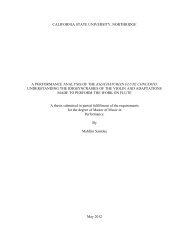2644 - CSUN ScholarWorks - California State University, Northridge
2644 - CSUN ScholarWorks - California State University, Northridge
2644 - CSUN ScholarWorks - California State University, Northridge
Create successful ePaper yourself
Turn your PDF publications into a flip-book with our unique Google optimized e-Paper software.
2686<br />
journal of Student Research Abstracts · 23<br />
EFFECT OF MAGNETIC FIELDS ON THE PRODUCTION OF CARBON<br />
DIOXIDE BY SACCHAROMYCES CEREVISIAEDURING FERMENTATION.<br />
Joe Ho Tam and Steve DeGusta (teacher). John F. Kennedy High School, 6715 Gloria Drive, Sacramento,<br />
CA 95831.<br />
The problem investigated was the effect of magnetic fields on the production of carbon dioxide by<br />
Saccharomyces cerevisiae, baker's yeast, during fermentation. Magnetic fields have been found by the EMF<br />
RAPID program to indirectly promote cancer. I hypothesized that the magnetic fields, produced by standard<br />
bar magnets 6"Xl/2"Xl/4" (Argus WLS-44375-10), will cause cancerous growth, and therefore more yeast<br />
cells will be present. Then the volume of carbon dioxide produced by the yeast exposed to magnetic fields will<br />
be more than the volume produced by the control. I set up ten trials, each with a 25mL yeast/sugar suspension<br />
in a 50mL tube, one with two bar magnets and the other with index card paper of the same size as magnets on<br />
each of two sides. The tubes were left for 24 hours. After the elapsed time, using a technique involving water<br />
displacement by carbon dioxide, I measured the production of carbon dioxide during a 20 minute period. The<br />
results from both the original experiment and a modified one showed that my hypothesis was false because the<br />
p-value in both were greater than 0.1. This showed that the magnetic fields had no effect on the carbon dioxide<br />
production by yeast.<br />
2687<br />
THE EFFECTS OF AN INCREASE IN VITAMIN B 12 ON THE PHOTOSYNTHETIC<br />
RATE OF EUGLENA UNDER DIFFERENT COLOR WAVELENGTHS.<br />
Lue Yang and Steve DeGusta (teacher). John F. Kennedy High School, 6715 Gloria Drive, Sacramento, CA<br />
95831.<br />
The purpose of this investigation was to test whether adding an increased dosage of an essential growth vitamin<br />
increases the rate of photosynthesis of euglena gracilis under different wavelengths; assuming that the<br />
growth rate has a direct relationship to the production rate of photosynthesis. 250 meg each of vitamin B 12 was<br />
added into four 25 ml cultures of Euglena. The four cultures with the vitamin B 12 were then placed in red, blue,<br />
green and white light by adding food coloring, with white light having no food coloring. In doing so, we can<br />
determine if vitamin B 12 increases the growth in each color more or less than just the light treatments alone.<br />
Four other cultures (controls) were given the same light treatments, but without the vitamin. The cultures were<br />
allowed to grow for a couple of days. Random samples from each culture were placed on a hemacytometer and<br />
the numbers of cells in 1 sq. mm were recorded for six days. From statistics, the green and white groups had<br />
a p value between .2 and .05. Both the red and blue groups had a .05>p>.01 therefore rejecting the null hypothesis<br />
and stating that the variation between the cultures treated with vitamin B 12 and those without were due to<br />
the vitamin treatment. However, from the data collected, the high dosage of the vitamin treatments did not<br />
increase the growth rate of Euglena, but rather slowed or decreased it because the total numbers of cells in all<br />
the cultures with vitamin B 12 were less than those without the vitamin. However, this decrease in cells was not<br />
necessarily the result of an overdose in the vitamin. It may be that the fillers holding the vitamin affected the<br />
growth of euglena.













